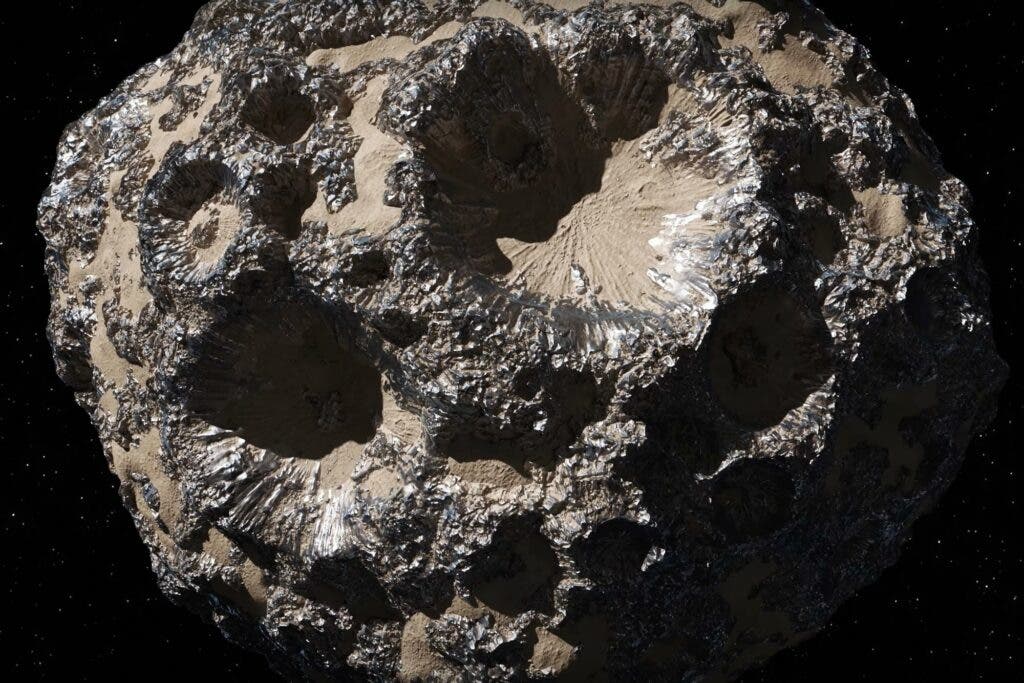A sneak peek at the asteroid Psyche, provided by an array of NASA telescopes in Chile, hints at a very lively history for the body which includes metallic eruptions, asteroid impacts, and even a now-lost rocky mantle.

Psyche is the target of an upcoming NASA mission later this year. During this, a probe will spend almost two years orbiting and analyzing Psyche to give us a better understanding of how it formed. As such, the asteroid is understandably drawing quite a bit of attention from astronomers around the world eager to tease out as much data about it as possible for the upcoming mission.
As part of this effort, a trio of US researchers has used readings from an array of telescopes in northern Chile to create the most detailed map to date of the asteroid’s surface properties. The map reveals swathes of metal-rich areas on Psyche, along with a large depression that could give us a glimpse through its surface into the ancient mantle below.
An eventful history
“Psyche’s surface is very heterogeneous,” says lead author Saverio Cambioni, the Crosby Distinguished Postdoctoral Fellow in MIT’s Department of Earth, Atmospheric and Planetary Sciences (EAPS). “It’s an evolved surface, and these maps confirm that metal-rich asteroids are interesting, enigmatic worlds. It’s another reason to look forward to the Psyche mission going to the asteroid.”
The featured face of Psyche suggests that this celestial body has had quite a dynamic history, the team explains. Its surface features are surprisingly varied for an asteroid of its size, they add, and each offers a unique hint at what Psyche has been through.
The rocky outcrops on Psyche could be the remnants of an ancient rocky mantle similar in composition to the outer layers of Earth or Mars. That being said, until we actually get a better look, we won’t know for sure; they could also be the remnants of past impacts with space rocks. What the team is quite confident in is the metallic structures on Psyche. They support previous theories that the asteroid likely experienced eruptions of metallic lava during its early days before its core cooled down and hardened.
Although the surface composition of Psyche has been heavily investigated in the past, using telescopes that peer into the infrared light reflected by the body, researchers have had significant difficulty actually using this data in a meaningful way in the past. The main issue was resolving the spatial variations in composition over the asteroid’s surface; in other words, we knew what materials its surface was made of, but we didn’t know which material went where.
The team was able to overcome this limitation, and map out Psyche in finer detail than ever before — at around 20 miles per pixel — by pooling the data obtained from 66 radio antennas of the Atacama Large Millimeter/submillimeter Array (ALMA) in northern Chile. This collection of data was obtained on June 19, 2019, when ALMA focused its entire array on Psyche.
“The signals of the ALMA antennas can be combined into a synthetic signal that’s equivalent to a telescope with a diameter of 16 kilometers (10 miles),” says co-author Katherine de Kleer, assistant professor of planetary science and astronomy at Caltech. “The larger the telescope, the higher the resolution.”
On June 19, 2019, ALMA focused its entire array on Psyche as it orbited and rotated within the asteroid belt. De Kleer collected data during this period and converted it into a map of thermal emissions across the asteroid’s surface, which the team reported in a 2021 study. Those same data were used by Shepard to produce the most recent high-resolution 3D shape model of Psyche, also published in 2021.
The final step of the research was to run a series of simulations to see which distribution of surface properties would best match the thermal emissions obtained by ALMA. Such simulations assumed different combinations of materials on Psyche’s surface, such as different abundances of various metals. The team ran these simulations “area by area”, Cambioni explains, in order to allow for greater accuracy of the process.
Overall, the team reports that the asteroid’s face is likely rich in metals, although the ratios of metals and silicates varied quite significantly across its surface. Another interesting finding was that, as the asteroid rotates, the material inside a large depression changes temperature much faster than that around the rim, suggesting that the bottom of this structure is covered in patches of fine-grained material like sand, while the rims are made of rockier material.
“Ponds of fine-grained materials have been seen on small asteroids, whose gravity is low enough for impacts to shake the surface and cause finer materials to pool,” Cambioni says. “But Psyche is a large body, so if fine-grained materials accumulated on the bottom of the depression, this is interesting and somewhat mysterious.”
“These data show that Psyche’s surface is heterogeneous, with possible remarkable variations in composition,” says Simone Marchi, staff scientist at the Southwest Research Institute and a co-investigator on NASA’s Psyche mission, who was not involved in the current study. “One of the primary goals of the Psyche mission is to study the composition of the asteroid surface using its gamma rays and neutron spectrometer and a color imager. So, the possible presence of compositional heterogeneties is something that the Psyche Science Team is eager to study more.”
The paper “The Heterogeneous Surface of Asteroid (16) Psyche” has been published in the Journal of Geophysical Research: Planets.


